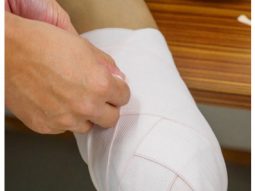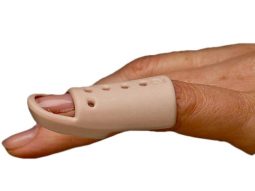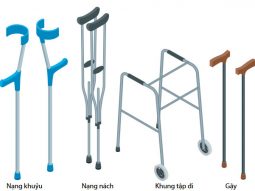WHAT ARE WALKING AIDS?
Walking aids are mobility assistive equipment recommended by your doctor or your physiotherapist. They maintain or improve your mobility and independence when you are not able to bear, fully or partially, your weight on one of your legs, because of injury, surgery or pain. Walking aids may also be recommended when you have muscles weakness or poor balance, to improve your functional capacity, your level of mobility and optimise your safety.
Walking aids may be used for a short period of time during the healing and the recovery process or may be used for long term in case of disability, aging, or degenerative disease.
The most standard walking aids are forearm crutches, armpit crutches, walking frame and canes. However, your physiotherapist may provide many other specific walking aids in term of size, materials and additional features. Do not hesitate to contact your physiotherapist for further information.
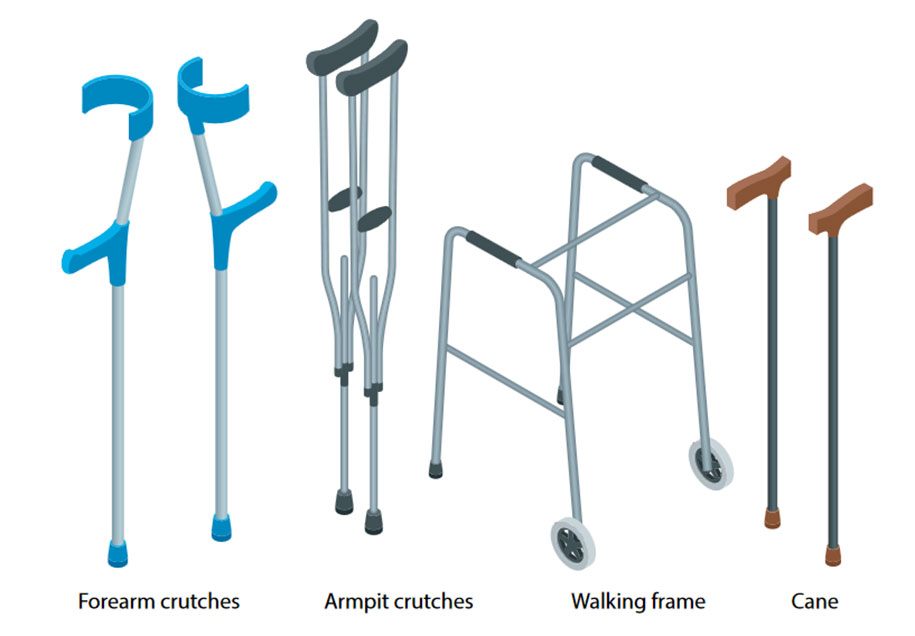
HOW TO SELECT MY WALKING AID?
Not all the walking aids can fit to your needs.
Selecting a walking aid includes taking in consideration your height, weight, health care plan, risks factors and your strength and limitations. Inappropriate selection of a walking aid may compromise your safety, your recovery or increase the risk of falling. For the most appropriate advice on walking aid selection, your doctor should refer you to an experienced physiotherapist who will assess your abilities and your risks factor.
| Type of walking aids | Who can get that device? |
| Forearm crutches | People with strong upper body and good balance |
| Armpit crutches | People with weak upper body |
| Walking frame | People with poor balance |
| Cane | People needing light assistance |
Do not use walking aids if you feel unsafe or uncomfortable and contact your physiotherapist who will select and fit a device for you. Your physiotherapist may also recommend you alternative equipment solutions to maintain your lifestyle and your autonomy. It can be by selecting different walking aid based on your activities, wheelchair assistance or developing a rehabilitation programme. The rehabilitation programme may help optimising the recovery of your strength, balance for a more effective use of your walking aids.
HOW TO FIT YOUR WALKING AID?
When the correct walking aid has been selected for you, it is necessary to fit it properly to your body to optimise comfort, ensure safety and prevent from further injury.

For forearm crutches, walking frame and cane, adjust the handles at wrist level
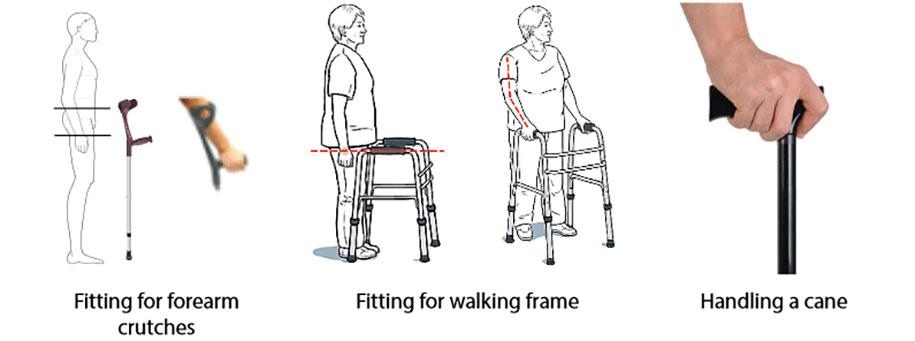
For armpit crutches, start by adjusting the armpit level, then proceed as for other walking aids.
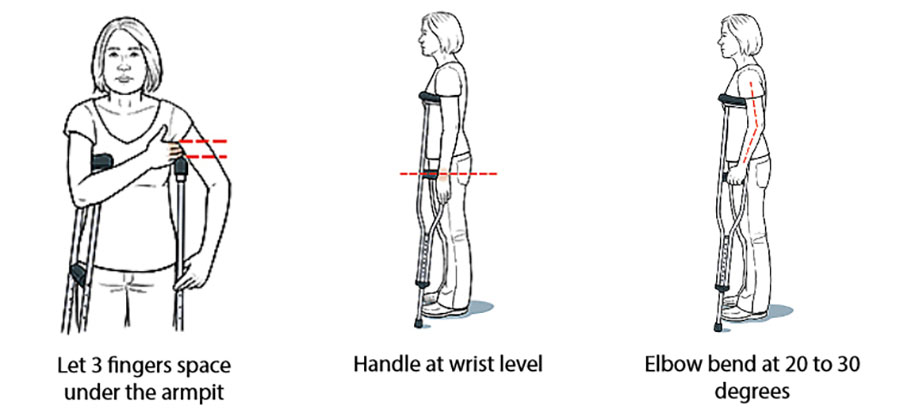
AM I AT RISK OF FALLING?
When using a walking aid, you are at risk of falling as your gait pattern, your strength and your balance is affected. A well-fitted equipment and proper gait training by physiotherapist minimise this risk of falling. Use your walking aid as recommended by your physiotherapist and follow the recommendation for minimising other factors which may compromise your safety such as environment, medication or your general health.
Seek for the support of your family for setting a safe environment and be aware of the factors which increase your risk of falling:
- Avoid unsteady surfaces (beach, gravel, mud etc.);
- Avoid slippery surfaces (wet or waxed floors or smooth cement floors). Be careful in the kitchen or bathroom area;
- Watch out frequently for uneven surfaces;
- Ensure adequate lighting;
- Remove rugs, especially if placed on waxed floors;
- Remove telephone or other extension cords;
- Avoid crowded places;
- Be careful with children toys;
- Be careful with pets;
- Do not let children or others playing with your crutches.
To optimise your safety:
- Use walking aids only on firm ground;
- Wear non-heeled and well-fitted shoes;
- Check twice per week the rubber tips of your crutches, especially if you walk outdoors.
Another factor that may increase the risk of falling may be the medications you are taking that reduce alertness (sedative drugs or anti-anxiety drugs) but also alcohol consumption.
In case you feel unwell, tired or in pain, seek advice immediately from your doctor or your physiotherapist. Ask for assistance of your family, friends and avoid using your device alone until you have received further information.
HOW SHOULD I DO THE MAINTENANCE AND THE CLEANING OF MY WALKING AID?
Your crutches do not need specific maintenance except changing rubber tips when they are worn. New rubber tips can be collected from where you bought your device.
In case you detect damaged parts on your walking aid, such as the tube, handle or locking system your crutches must be discarded and replace immediately.
Clean your walking aids with a mild detergent or soap, wiped off with water and then dried with a clean cloth. Clean daily your handgrips. Do not immerse the device in water.
If you have any problem with your walking aids, please contact us.
WHY MY DOCTOR REFERS ME TO PHYSIOTHERAPY SERVICES?
When you are using walking aids or mobility assistive devices, your doctor should recommend you to undergo physiotherapy programme so you can safely and effectively use your device. This will fasten your healing and your recovery as well as to prevent recovery delay. This physiotherapy programme includes:
- Gait training with crutches;
- Guidance to reduce pain and inflammation;
- How to prevent gait disorders, limp;
- How to prevent f joint stiffness, muscle weakness and neurovascular disorders;
- Enhancement of your posture and your balance;
- Develop alternative solutions for maintaining activities at home, school and work.
HOW MAY I IMPROVE MY BODY DURING THE TIME USING WALKING AIDS?
At any time, you can improve your body condition by following the medical recommendations, adjusting your level of activity, and managing your pain by following your physiotherapist’s recommendation.
However, you can help:
- Improve the blood circulation of your legs:
- When you are not up and about, organise rest times to elevate your injured leg, this will prevent foot or leg swelling:
- In a sitting position, raise your foot higher than your hip. Provide support under your leg. This prevents knee strain;
- In a lying position, raise the foot 5 to 10 cm off the bed up by placing bricks or books underneath. Placing a pillow under your calves is not recommended as it may hinder blood circulation.
- Curl and stretch the toes of both feet 20 times every hour.
- Work to develop the strength of your arms and upper body.
HOW TO USE WALKING AID?
During your first use of walking aids, your physiotherapist is the most qualified person to explain, demonstrate, instruct and provide advice you need for a safe and appropriate use.
Footwear should be appropriate and supportive
Walking equipment should not be used on slippery or wet floors
Walking
A. If you are advised to walk with full weight bearing:
Crutches, walking frame or a cane could help you to preserve a well-balanced gait and allow for a faster recovery. If your physiotherapist advises you to use only one crutch, or one cane, handle the device on the opposite side of your “weak leg”.
- Put your crutches or walking frame forward.
- Step your “weak leg” forward to your crutches.
- Lean your weight onto your crutches and your “weak leg”.
- Step your “good leg” forward, past the “weak leg”.

When you achieve good balance, please repeat steps 1 to 4.
B. If you are advised to walk with partial weight bearing on your injured leg:
Two crutches or a walking frame are needed. Respect the partial weight bearing advised by your doctor.
- Put your crutches or walking frame forward.
- Step your injured leg forward to the crutches/walking frame and land your injured leg on the floor.
- Lean your weight mostly onto the crutches/walking frame and partially on your injured leg.
- Step your “good leg” forward, past the injured leg.
When you achieve good balance, please repeat steps 1 to 4.
C. If you are advised not to have any weight bearing onto your injured leg:
Two crutches or a walking frame are needed. Respect the non-weight bearing advised by your doctor.
- Put your crutches or walking aid forward.
- Step your injured leg forward to crutches/walking frame ensuring your injured leg is kept off the ground.
- Lean your weight onto your crutches/walking frame.
- Step your “good leg” just past your injured leg.
When you achieve good balance, please repeat steps 1 to 4.
Sitting
A. Sitting down
- Turn and back up to the chair until you feel the edge of the chair against the back of your “good leg”;
- Remove the crutches from your hands and place them against a support. Make sure they are easy to reach for standing up later;
- Carefully put your “weak leg” slightly forward;
- Reach back with your hands for the armrest or edge of the chair and lean your weight on your hands;
- Gently bend your body forward at the same time as you are bending the knee of your “good leg”. Place your weight on your hands as you are sitting down.

B. Getting up
- Always make sure that your crutches are easy to reach;
- Sit on the edge of your chair;
- Bend your “good leg” against the chair and put your “weak leg” slightly forward;
- Hold the chair or armrests with both hands. Bend your body forward and push yourself up. Lean your weight on your hands to get up on your “good leg”;
- Make sure you are well-balanced before taking your crutches.

Using stairs
Use stairs only after having been trained and allowed to do so by your physiotherapist.
Use the handrail if available. People using a walking frame are not allowed to go up and downstairs by themselves.
A. Climbing upstairs
- Face the stairs and walk up close to the bottom;
- Keep your crutches on the same level that you are standing;
- Lean your weight on your hands and step up your “good leg”;
- Follow with your “weak leg” and crutches
When you achieve good balance, please repeat steps 1 to 4.
Remember: “Up with the good leg”

B. Climbing downstairs
- Stand with the toes of your “good leg” close to the edge of the step;
- Lower your crutches to the step below;
- Lean your weight on your hands;
- Slowly lower your “weak leg” on the same step as your crutches, followed by your “good leg”.
When you achieve good balance, please repeat steps 1 to 4.
Remember: “Down with the “weak leg”

For any further information, please contact
Physiotherapy & Rehabilitation Department
FV Hospital 1st floor
Tel (028) 54 11 33 40
Or (028) 54 11 33 33 ext 1085 – 1485

 Vi
Vi 
